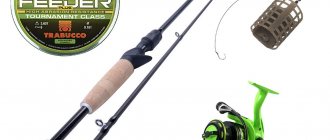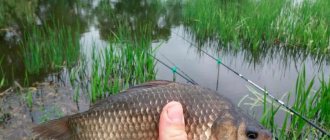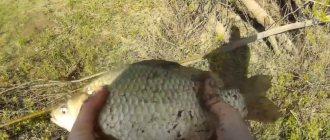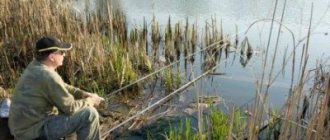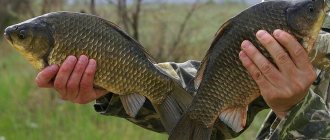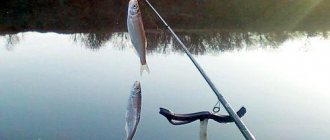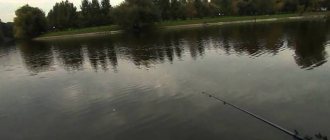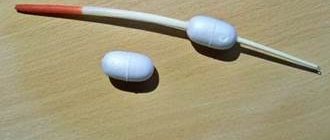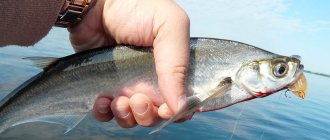Before deciding on the gear, you need to clarify the purpose of fishing - spinning fishing or fishing with a fishing rod and float. For the second option, the gear should be accessible, easy to assemble and easy to operate. You can catch perch, roach and other types of fish with a float rod.
What is float fishing
Fishing with a float is not only a way of catching fish, but also a special form of relaxation and pleasant pastime. In order for this event to be successful, you should take into account the temperature of the water, the reproductive characteristics of each type of fish, and the method of feeding.
For the classic version of fishing with a float, it is worth purchasing a telescopic rod with rings no more than 5 meters long, and several types of fishing line. You should also get sinkers and hooks of different sizes, floats and a reel.
In order for float fishing to be successful, you should not only choose the right gear. Success depends on how well the bait is chosen, the time and place of fishing.
Fishing with a feeder using a pop-up boilie
Finally, a feeder rod can be used when fishing with a pop-up boilie. To do this, you only need to add a leash with a hair mounting - the boilie will be installed on it. The equipment is similar to that used when fishing with a marker float: a monofilament leash with a sinker is attached to a knot between the hook and the marker float itself. This fishing method will be more effective in shallow reservoirs up to one and a half meters deep. It is most often aimed at carp, which equally like to feed both in the water column and at the surface. It is only necessary to carefully monitor the depth of immersion of the nozzle in accordance with the behavior of the carp in the given area.
Feeder is a fishing tool with unlimited possibilities for modernization
Thus, it becomes obvious that the feeder is a truly limitless tool in its modernization possibilities. Time and experience of professional fishermen have shown that using a feeder rod is possible with fishing gear using methods completely different from feeding methods; moreover, such combinations often show unexpectedly good results, surpassing both traditional fishing methods and the classic feeder itself. All you have to do is choose the options that are right for you and applicable to the types of fish and bodies of water you have planned.
Types of rods
And so, let's take a closer look at the types of fishing rods.
Bologna rod. This is a telescopic device with rings, having a length of 4 to 7 meters. The kit includes a reel of an inertial or non-inertial model, a fishing line of 0.14-0.16 mm, a float, a weight and a hook on a leash. Such rods are used for casting or for fishing in the current. This is a very good option for beginner fishermen.
Match rod. This is a telescopic or collapsible rod based on a plug connection with a length of 3.5 m to 4.8 m. It can consist of 3 or 4 legs, and also has guide rings on a long leg. Thanks to their unique design, such fishing rods have excellent strength and low weight. They can be used to catch fish weighing about 3.5 kg at a distance of 15 to 70 m from the shore.
Fly rod. This design consists of telescopic elbows made of carbon or fiberglass. The rod does not have a mount for a reel or guides. The length ranges from 3 to 10 m, but options with a length from 4 to 7 m are usually in demand. It is intended for fishing from a vessel or shore.
Feeder rod. The design, 4.8-4.9 m long, has pass-through rings and a mount for a reel with cord or fishing line. Feeder rods are equipped with flexible tips called quivertips. They, as a rule, have access rings and are used to register bites. The length of the quivertype is about 35 cm, and this device can be removable or stationary.
Casting rod. In such designs, the passage rings have a small diameter and are located. The reel seat is also equipped with a special trigger. All this makes it possible to increase the sensitivity of the gear.
Fly fishing rod. The design is designed for casting specific gear, and consists of a loaded fly line and a light fly.
Rod for winter fishing. First of all, the difference between such fishing rods is their low weight and short length. The design includes a reel, but it most often plays the role of a fishing line holder, since rewinding is most often done manually.
Types of fishing floats
There are unique types of fishing floats, the description of which is below.
Smart float. There are many species of fish that are active at dusk or at night. Moreover, at night, the options for catching a larger specimen increase. Since it is quite difficult to visually control a regular float in the dark, gear with different types of signals is used. A smart fishing float is distinguished not only by a longer antenna, but also by a special device. It consists of a sensor, LED and battery. This mechanism reacts to movement during a bite and changes the glow. A smart fishing float makes it possible to hook a fish in time at the moment when it has stopped playing with the bait and has already taken it.
The design allows you to change the battery if the charger runs out. A flexible and elastic antenna and 7 luminous sections distinguish this float from other devices. One battery charge lasts for 35 hours of continuous operation. In order to turn off the LEDs, you need to unwind the float.
Glowing, or firefly float. The design of the luminous float includes a transparent tube with a capsule and two reagents in a liquid state. After these two substances have reacted, the float will begin to glow softly. The firefly is attached to the antenna of a regular float. Its duration lasts about 10 hours.
This is a disposable device that can only be used effectively at high temperatures. This float is perfect for night fishing.
Nod float. This tackle is used for fishing in bad and windy weather conditions. The nod float design consists of a rod inserted into a ball made of lightweight material, such as polystyrene foam.
This design is also equipped with additional weighting and painted in bright colors.
Electronic float. Such floats have not seven, but one section that lights up. The electronic fishing float is made of lightweight plastic and floats well on the water.
The kit includes a replaceable electric battery that is designed for 300 hours of illumination. The optimal type of glow has been selected, which does not scare off fish and makes it possible to notice the device on the water surface in the dark.
Sliding float. Sliding fishing floats are not fixed to the fishing line, but slide between two clamps, one of which is located near the sinker, and the second serves as a depth limiter. This design allows for more accurate long-distance casting. At the moment of casting, the float is located directly next to the hook and sinker, this makes it possible to release the optimal amount of fishing line.
After the tackle has hit the water and has begun to sink, the hook and sinker are lowered to a depth until the float ring reaches the depth limiter. For such gear, it is better to use a regular fishing rod, since the telescope may break.
Classic floats. The shape and design of a classic float depends on its purpose, but the kit necessarily includes a body with a loop for passing fishing line, a keel and an antenna. All elements must be balanced. Also, each product must have a marking indicating the loading weight.
The body is made of wood or plastic. For fishing in calm water, oblong-shaped floats are used, and for fishing in currents, more rounded shapes are used.
The carina is the spoke that comes out from the lower part of the body. It stabilizes the bite alarm during retrieving.
The antenna can be solid or hollow. The first option is highly sensitive and is used for catching wary fish species. Hollow antennas are more buoyant and are used for fishing at depth with heavier baits.
Classic floats include sports, amateur, flat, match, and Bolognese.
Homemade floats. What should homemade fishing floats look like? To make this design, a foam ball, a lead sinker, a cambric, a plastic tube or a wooden toothpick are used.
In order to make the foam more durable, it should be rolled with a hot iron. A toothpick is inserted into the hole, cambrics are placed on both ends, and a weight is secured to one end.
On a feeder with a float Fishing
On a feeder with a float
Fishing with foam is exciting, exciting and rewarding. But, as I already wrote (Five grains of pearl barley), it is not always possible to put the feeder on the bottom - algae or snags interfere with this. What if you hang the feeder above the bottom? There is no need to change much: I removed the sinker from the spring feeder and equipped it with a sliding “pike” float. In the air, a filled feeder weighs decently, which allows you to make fairly long casts.
In water, only the spring itself acts on the float, the food weighs almost nothing, so you don’t need a huge float, just to hold the empty feeder. In the fish-poor waters of the Moscow region, it was not possible to fully test the tackle and surpass previous catches, but we managed to understand that the tackle works. Several crucian carp, roach, bream, and chub were caught with this tackle. I even caught one saberfish, where did it come from in the quarry? It’s a pity that in our quarry we don’t have such foam lovers as grass carp and silver carp; they probably would have liked this tackle at the right time. With such gear you can fish above the bottom, in half the water, at the very surface! It can be difficult to calculate how much bait to soak for the entire fishing trip; sometimes there is not enough of it, sometimes there is some left over. I made a homemade spring with a distance between the coils slightly smaller than a feed pellet. Now I don’t soak the feed, I load the feeder like a pistol clip, pushing granules and pieces of white bread between the turns. Very comfortably. I used as much as needed! Swelling in water, feed crumbs slowly pour out of the feeder and attract fish. Bread crumbs are the first to begin their attractive effect; they are easily separated from the spring when they fall on the water. And when the fish have gathered at the fishing point and the feeding begins, you can do without bread.
I really enjoyed fishing on a feeder with a float! The bite alarm does not interfere with casting, the bell does not ring obnoxiously, irritating neighbors. The feeder flies freely, naturally, no overlaps! And then, I love looking at the float! A beautiful and sensitive float on the water is so cool. Now I also fish from the bottom using a feeder with a float. I make the depth so that the float is lying, and as soon as it rises, I immediately hook! For sure! The twitching of the float only means that the fish has approached and a bite will soon follow, be on the lookout!
Encyclopedia of fishing: https://vk.com/wall-23927120?q=feeder
https://vk.com/ohota_i_rybalka#post-23927120_4695
Fishing line and leashes for fishing
Fishing lines and leashes for fishing are made from different materials.
The nylon line is transparent but visible in the water.
The nylon fishing line is abrasion-resistant, durable and invisible in the water. This is an affordable and irreplaceable material, especially for winter fishing and float fishing.
The material for the manufacture of braided fishing line is high-modulus polyethylene. Such fishing line may differ in the number of fibers, the method of weaving and impregnation. This material is characterized by high strength, stability, lack of memory, low level of elongation, and durability.
The leash is a part of a thinner fishing line that is located between the hook and other elements of the equipment. The leash makes it possible to keep the equipment intact if a very large specimen gets on the hook, or you get a “dead hook.”
For a classic leash, material of smaller diameter and strength is used. Such options are used when fishing along the bottom with a high risk of snags and breaks, or if long-distance casting is used under extreme conditions.
If fishing with a fishing rod and float occurs at great depths, with strong currents or wind, then use leashes with a diameter of 0.16-0.18 mm. If the fish in the pond are very careful, then material with a diameter of 0.08 mm is used.
To catch predatory fish species, durable material made of nylon, steel or tungsten is used. Also very effective are leash options made from a mixture of polymer and metal fibers and fluorocarbon.
Equipment of a float rod for bream
The use of float tackle when fishing for chebak is characterized by a high catchability rate, the main thing is to understand that the object of fishing is not suitable for the coastal zone, the tackle must have the appropriate length.
The best option for a float fishing rod is a plug form; with its help you can fish a selected square in a pond and deliver the bait as accurately as possible. It is quite acceptable to use Bolognese and fly rods.
https://www.youtube.com/watch?v=ebTYYji63CM
- Inertia-free reel model with size 1500 – 2500.
- A braided thread with a cross-section of 0.15 - 02 mm or a monofilament with a diameter of 0.17 - 0.25 mm and a length of 100 m is suitable as the main fishing line.
- As a leader material, you can use monofilament fishing line with a cross-section of 0.1 - 0.15 mm and a length of 30 - 50 cm.
- Sliding float type with single point attachment.
- When choosing a load, the strength of the current is taken into account, 6 – 12 g.
- The hook number depends on the weight of the bait, No. 6 - 14.
The type of float depends on the specific fishing conditions (in particular on the fishing speed), namely:
- For fishing in reservoirs with strong currents, it is rational to use products with a thin keel and a flat body shape;
- For reservoirs with standing water, it is effective to use the classic version of a float with a thin cylindrical body.
To make it easier to observe the bite, it is recommended to use brightly colored floats.
Another important detail in the equipment of a float tackle is the weight; pellets can also be used, but the sliding version of the weight is considered more effective. So that the bream does not suspect anything when the bait is lifted from the bottom, it is recommended to place all the weights along the main line: the heavy one at the top, and the lighter one closer to the leash.
And here's what you need to know: How to choose a feeder - Fishing with a feeder
Float tackle works well in small water areas, where its length is enough to fish the selected area.
simple feeder equipment
Feeder tackle depending on the fishing location:
- On wide rivers with currents, rods with a length of 3.9 - 4.2 m are suitable, casting range 70 - 100 m;
- For fishing in small lakes, backwaters and rivers, use a stick with a length of 3 m.
Tackle components:
- A carbon rod with a test load of 80 – 120 g is ideal for catching bream in the current.
- An inertia-free reel model with a size of 2500 - 4000 and a capacity of 150 m3, you can use a carp reel or budget options designed for spinning fishing.
- High-quality monofilament with a cross-section of 0.2 - 0.25 mm, Salmo Feeder Specialist products have proven themselves well. Braid is ineffective here, given the large weight of the feeder, the thread wears out. As a leader material, it is advisable to use fluorocarbon fishing line with a cross-section of 0.2 - 0.25 mm.
- Open weight feeders (cages) with a weight of 80-120 grams work ideally in reservoirs with strong currents, but oval-shaped feeders should be used in standing water near the coastal zone;
- High-quality hooks are also selected taking into account the expected size of the prey: for trophy specimens, 37 - 10 are used, for catching medium and small fish, No. 10 - 14.
Helicopter and two knots
Allows you to hunt bream using light bait (a bunch of maggots). To make a helicopter you will need a rigid fishing thread with a diameter of 0.25 - 0.35 mm; fluorocarbon fishing line works well.
Manufacturing instructions:
- A fishing line with a length of 20 cm is folded in half.
- Tie a small knot, retreating 15 cm along the line folded in a figure eight.
- After 1 cm, twist another figure eight knot.
- Secure the feeder using the “loop-to-loop” method.
- To fix the leash, a throw is made between the first and subsequent knots without twisting the knot.
Symmetrical and asymmetrical loop
There are no significant differences in the installation principle. The differences are visible in the name, where a symmetrical loop has the same lengths of loops, and its antipode is one side shorter than the other, which has a very positive effect on the bite.
The symmetrical loop, despite its ease of assembly, is in no way inferior to the paternoster in terms of efficiency of use. The likelihood of tangling is minimal; it is more suitable for standing water. Equipment elements: main line, feeder, two swivels, leader line and hook.
- The thread folded in half must be twisted with rotational movements (in one direction).
- Tie a knot 6–10 cm from the twist.
- Secure the swivel to one fishing line.
- Make a knot 20 cm from the swivel.
- Twist.
- At the end of the twist, fix the swivel, and attach a leash to it, the length of which should not exceed 70 cm.
- The hook must be mounted on the leash in such a way that a large loop is formed.
- The feeder is mounted on a loop-to-loop swivel.
An asymmetrical loop is used especially effectively in reservoirs with standing water with a consistently calm bite.
- A fishing thread with a length of 50 cm is folded in half.
- Using a knot, the end of such a fishing line is tied to the main thread, the main thing is to get a large circle, it is necessary for attaching the feeder.
- The hook and leash are mounted to the loop.
Paternoster
Reels for float rods
A fishing line is attached to the reels for a fishing rod with a float. With its help, casting is carried out and its distance is adjusted. Inertial and inertialess reels are suitable for fishing with a fishing rod.
The inertial version is used for fishing in still water, from a boat with a short rod, or for short casts from the shore.
The inertial reel is lightweight, does not make sounds, and can be used to make a quick hook-up close to the shore. At the same time, the maximum cast that can be made is 10 m. There is no clip on it that will allow you to cast to the same place, and with its help it is very difficult to pull out a large specimen.
The spinning reel is equipped with a friction clutch, which makes it much easier to catch large fish. This design accommodates a larger amount of fishing line; it is equipped with a removable handle that can be rearranged for left-handed and right-handed people. All parts that fail must be replaced. This device is not intended for short casting.
Fishing in late autumn
These changes are especially noticeable on small rivers. On a warm summer dawn, it used to be that you anchored along the edge of the coastal strip of grass and, one might say, the fishing spot was found. Thickets of water lilies and carved elodea are common companions of shallow waters on the slope into the pit. This is understandable: shallow water warms up better and is saturated with sunlight. And if the place is located immediately behind the rift, on the widening of the river bed, then the water here usually flows around and this reach is most often quite deep and rich in fish.
In late autumn, the grasses fall, and the appearance of the river becomes unrecognizably stern and cold, to the point of slight melancholy. Moreover, after frequent long rains in the upper reaches, the water rises and the flow intensifies, almost like in spring. In the summer, stripes, islands and half-islands of grass dampen the flow and create eddy currents with a reverse flow. In autumn, the river streams move according to their own freer laws. It becomes more difficult to find edges and drops into the pit. But most often, catchable places are located near the border of rapid jets, at the transition of their jets into reverse movement. Often large fish come to the shallows where vegetation still remains. This applies to both predatory fish and silvery cyprinids. The meager autumn sun still warms up such places and the most varied little things frolic here, as if for the future before winter snowstorms and frosts. Gloomy predators rise from the black depths and greedily feed on small “linen”. Here, in the thickets of reeds and grass that has not yet fallen, you can often see the breakers of quite large golden-scaled fish. This is an autumn bream, rather sluggish, but still taking the bait from time to time.
Sinkers and hooks
For fishing with a float, light and small sinkers are suitable.
Based on their form, they can be divided into the following types:
- A shot is a weight in the shape of a lead ball with a small slot. There are several options for shot by weight and size;
- olive - this sinker is shaped like an olive. This type of gear is used at greater depths or in bodies of water with a current. Sometimes an olive and several pellets are used on one fishing rod. Olive is also more convenient for long casting;
- sheet lead is an excellent material for making weights yourself. Lead sheets are available in different thicknesses. The material is quite soft, easy to cut and flatten.
To catch small species of fish, thin and sharp hooks are used. It is also important to choose the right size and tie the fishing line correctly.
If you plan to catch fish of medium and large sizes, from the shore or boat, you should use high-quality sharp products made from thin and medium-thick wire. Such fish are very careful, for this reason it is worth using hooks that have a dark color or a protective coating. The sting can be straight or curved inward.
Tips for catching bream on a feeder
In conclusion of the article, I would like to highlight some of the features of catching bream on a feeder depending on the time of year, as well as answer frequently asked questions from novice anglers.
Bream fishing in spring
In the spring, when the ice on the reservoir has melted, you can start fishing, namely catching bream on a feeder. But fishing at this time brings some inconvenience to the fisherman, since it is not clear where the bream is standing. It may be in wintering pits, or it may have already entered shallower, warmer areas. I recommend having two rods and feeding two distances. A wintering hole is not difficult to find. As a rule, in winter, in such places on the ice, entire tent camps are organized for those who like to catch winter bream with jigs.
Also in the spring there are some restrictions on bait. In winter, spring and autumn, the bait should not be too sweet and flavored, since the fish at this time are very cautious and timid.
But if you caught bream from under the ice in winter, and it responded well to some kind of aromatic additive in this place, you can try adding it in the spring. You can also add molasses to the bait.
Molasses activates digestion and helps keep the bream at the point.
After the bream spawns, it begins to feed very actively, but it feeds anywhere and everywhere, for this reason it is difficult to keep it on the spot.
Bream fishing in summer
As soon as the bream moves away from spawning, more stable summer fishing begins. It reacts well to the smells of spices in the bait and sweet fruity smells, which can be used to permeate the bait, or you can additionally spray the bait.
You can also find bream in more familiar places, on the lower edges or, if there are none, then at the transitions from a soft bottom to a hard one.
Bream fishing in autumn
As the water temperature begins to drop, fall feeder fishing for bream will begin to resemble spring fishing. The bream becomes less active, timid and begins to slide into wintering pits.
Why doesn't bream bite on the feeder?
Please note some mistakes due to which catching bream on a feeder may not be effective.
- The fishing point is not chosen correctly, the distance should be changed
- The bait mixture is not suitable, you should try adding a coarse fraction, a live component or another flavoring
- The bait is not suitable. I recommend constantly changing bait combinations.
- Rough tackle, reduce the diameter of the leader, increase the length of the leader and reduce the hook
How to properly land bream on a feeder
If you are lucky enough to get a bite from a bream and on that side of the fishing line or braided line you feel a pleasant resistance, then you are doing everything right. All that remains is to bring the bream ashore.
If you are fishing under a steep edge, then you need not to be lazy, get up from your seat and raise the rod as high as possible so that the fish does not hit the edge and an offensive derailment does not occur.
Further, when fishing near the shore, a landing net with a long handle will be of great help to us. You should put it in the water away from the shore and bring the fish onto the landing net. Otherwise, if you catch bream with a landing net like a butterfly, it may get scared, shake its head and break the leash. After all, the closer we get to the shore, the less shock-absorbing properties our gear has.
Float rod equipment
What is the equipment of a float rod? In cases where the rod has rings, a reel is installed on it, and the rings are used as a guide for the fishing line, which is threaded through all the rings.
A rod without rings has a special mount at the end for fishing line; it is tied using a figure eight knot. For this option, the fishing line should be the same length as the rod or be 50 cm longer. This design makes casting easy.
If the float has a ring, then the fishing line is threaded into it in the upward direction. After this, cambrics are put on the fishing line and the keel of the float.
If the float does not have a ring, cambrics are placed on the keel and top. It is important to select the correct size of such tubes and monitor the wear of the rubber bands.
In order to determine how correctly the float is loaded, it must be launched into the water. If the load is sufficient, only the float antenna should be placed above the water. If the whole body floats, the float will be less sensitive. This can only be allowed when catching predatory fish with live bait.
In order to connect the fishing line and the leash, you can use a loop-to-loop fastening. You can also use fasteners.
Fishing in the wire
Often the most effective way to catch bream is with a float rod in the retrieve. If the depth allows, you can fish from the shore, but fishing from a boat will be more effective. Since there is almost no grass at the depths, there are usually no obstacles to the movement of the bait, except for shallows and spits. But this will even be a plus: the freely moving bait suddenly stops and then moves in jerks, with slowdowns and accelerations, if, of course, the bottom allows it. Ideally, it is a sand spit with depressions without grass lying on the bottom. On the current, most often these shallows are quite clean.
Difficulties occur in determining the bite. Only experience can help here. The dive of the float when the hook with bait touches the bottom is more monotonous and monotonous. The bite of a large fish in the current is quite energetic, and in most cases the float lies on its side and then quickly disappears under the water. On a channel with a flat bottom, the bait should move near the bottom, which is determined by several of its cast-passes.
A fishing rod for live fishing should be light and easy to grip in the hand, since it has to be constantly held suspended. It is equipped with a lightweight, inertia-free reel, which allows you to maneuver the tackle and release the hook with the nozzle over a fairly long distance downstream. Naturally, for better visibility, the float must have a high antenna.
On some rivers, the bait can also be an ordinary worm or dung worm, but the real autumn bait is more likely to be a bloodworm. If it is possible to find burdock larvae or collect burdock larvae in strong stems, then planting them, tender and white-yellowish larvae, will give a result incomparable to planting tufts of bloodworms alone. Despite the apparent indistinguishability of burdock and Chernobyl larvae, the latter is for some reason more attractive to fish. At least I had to notice it.
To attach the bloodworms and the above-mentioned larvae, you will need a fairly thin and already medium-sized hook for winter. You can also knit bloodworm lobes in winter, grabbing them with a thin elastic band to the hook point. In this case, the bloodworm does not pierce or leak out, but lives for a long time and attracts fish with its natural scarlet color and movement.
There is one more feature of autumn fishing. If in spring and summer a large bream is tempted more by an appetizing bunch of worms than by one, even with a long tail, then in the fall, it happens that a seasoned fish suddenly becomes interested in one bloodworm, impaled in a semi-ring on the barely visible hook-swallow of a light fishing rod, thrown for some kind of track . Then all that remains is to rely on the lethargy of the pre-winter fish, the strength of the tackle and the complaisance of the local water fish... This law of meanness was also familiar to the famous Sergei Timofeevich Aksakov.
Bait for float rod
As bait for a float rod, you can use almost everything that is in the kitchen - bread crumb, corn, dough, boiled sausage, cheese. All fishing stores offer a large selection of natural baits. They should be purchased in advance, and it is important to take care of storage conditions. You can purchase hemp seeds in raw or prepared form. The raw grains are cooked until the black skin cracks. Dead small fish are used to bait pike. You can buy frozen sprat or herring.
You can also always find slugs or worms under stones or logs. In a pond you can catch caddisfly larvae or other insects that will undoubtedly attract fish.
Places for fishing with a float
In shallow waters it is worth choosing deeper places for fishing with a float. In fast-flowing rivers, you should give preference to whirlpools, bays and bends.
If the river is very large, then you should choose the confluence of small streams or rivers, places at turns with steep banks.
If the reservoir is low-flowing, then you should not choose very deep places for fishing, since there may be layers of water with low oxygen levels at the bottom.
Also suitable for fishing are places with coastal vegetation and under trees that hang over the water. Insects very often fall from them, which attract fish.
In cold weather, in spring or autumn, it is worth choosing places that quickly warm up in the sun.
